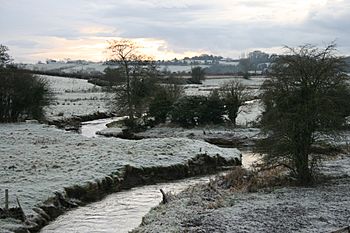River Greese facts for kids
Quick facts for kids River Greese (Griese) |
|
|---|---|

The Greese in County Kildare
|
|
| Native name | An Ghrís |
| Country | Ireland |
| Physical characteristics | |
| Main source | Dunlavin, County Wicklow ~146 m (479 ft) |
| River mouth | Celtic Sea at Waterford Harbour via River Barrow |
| Length | ~35 km (22 mi) |
| Basin features | |
| Basin size | 72 km2 (28 sq mi) |
The River Greese (sometimes called Griese) is a small but lively river in the southeast of Ireland. It's like a smaller helper river, flowing into the bigger River Barrow. Its name in Irish is An Ghrís.
Contents
What's in a Name?
The River Greese gets its name from an old place called Killeen Cormac. Long ago, this place was known as "Gris Chapel."
Over hundreds of years, people spelled the river's name in different ways, like Grys or Gryse. Today, "Greese" is the most common spelling, but you might also see it written as "Griese."
Where Does the Greese Flow?
The River Greese starts its journey near Dunlavin in County Wicklow. It begins in a place called Tober.
From there, it flows southwest and even forms part of the border between County Wicklow and County Kildare. The Greese continues west, passing by Killeen Cormac, the place it was named after.
Journey Through Towns
The river goes under the R448 road at Moyleabbey in County Kildare. It then meets another small river in Crookstown and flows under the R415.
The Greese continues south through the town of Ballitore. It keeps flowing south-southwest, passing under the M9 and through the Kilkea Golf Club.
Reaching the Barrow
The river flows past Kilkea Castle and goes under the Dublin–Waterford railway line. Finally, the River Greese empties into the River Barrow in a place called Jerusalem townland.
This last part of the river forms a border between County Carlow and County Kildare.
Wildlife in the River
The River Greese is home to several types of fish and other water creatures. You can find different kinds of fish swimming in its waters.
Fish You Might See

